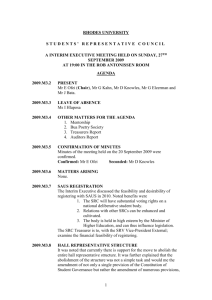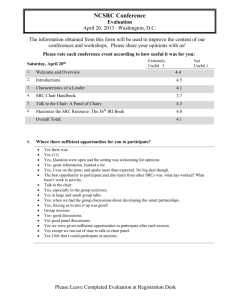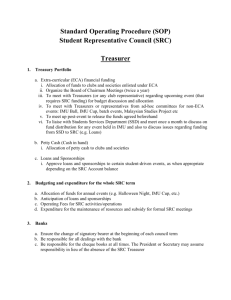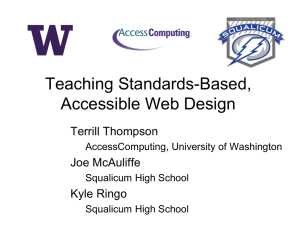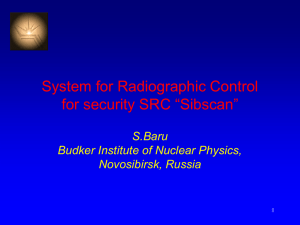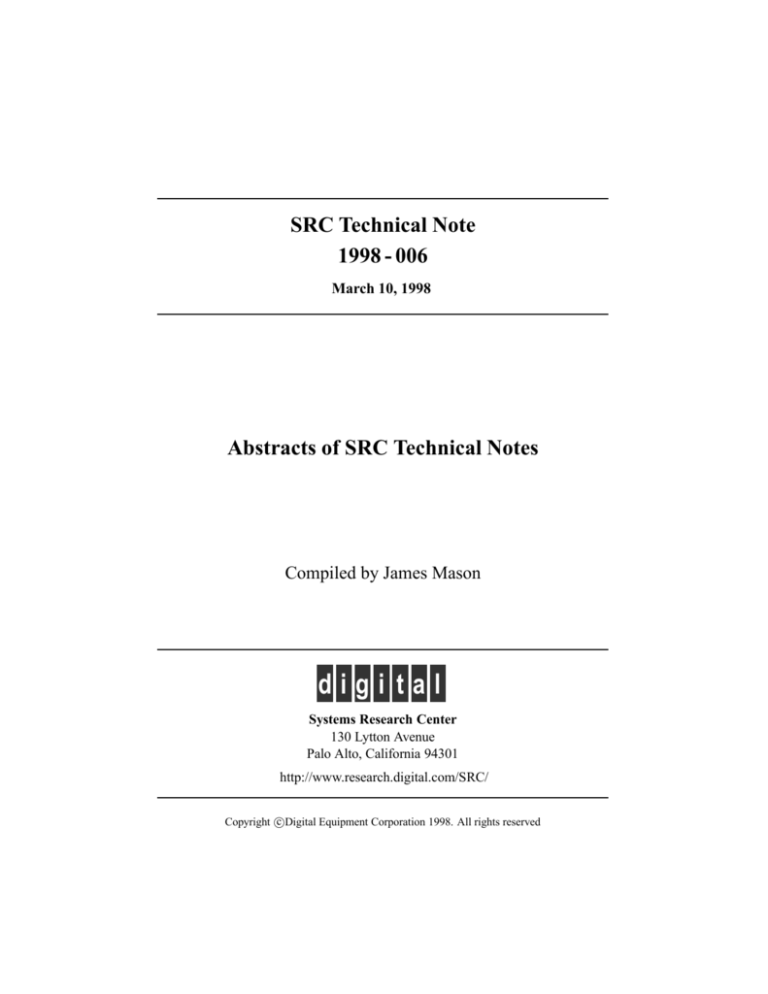
SRC Technical Note
1998 - 006
March 10, 1998
Abstracts of SRC Technical Notes
Compiled by James Mason
digi tal
Systems Research Center
130 Lytton Avenue
Palo Alto, California 94301
http://www.research.digital.com/SRC/
c
Copyright Digital
Equipment Corporation 1998. All rights reserved
c
Digital
Equipment Corporation 1998
This work may not be copied or reproduced in whole or in part for any commercial
purpose. Permission to copy in whole or in part without payment of fee is granted
for nonprofit educational and research purposes provided that all such whole or
partial copies include the following: a notice that such copying is by permission
of the Systems Research Center of Digital Equipment Corporation in Palo Alto,
California; an acknowledgment of the authors and individual contributors to the
work; and all applicable portions of the copyright notice. Copying, reproducing,
or republishing for any other purpose shall require a license with payment of fee to
the Systems Research Center. All rights reserved.
Abstract
This document presents abstract and title listings of all SRC Technical Notes published to date. The technical notes series provides a fast
track for the publication of work in progress, position papers, and interim results. The series is accessible at:
www.research.digital.com/SRC/publications/
Also at this web site is the SRC Research Report series and a feature articles section. The research report series consists of formal
publications that are peer reviewed while the feature articles provide
overviews of research projects for general audiences.
Information on how to retrieve technical notes and subscribe to publication announcements is given in section two of this paper.
Contents
1
Abstracts of SRC Technical Notes
1
2
Ordering Information
19
3
List of SRC Technical Notes
20
iii
1
Abstracts of SRC Technical Notes
• SRC Technical Note 1994-001
Introduction to TLA
Leslie Lamport
December 16, 1994. 7 pages.
A short introduction to what TLA formulas mean. It should allow you to
understand TLA specifications.
• SRC Technical Note 1996-001
Refinement in State-Based Formalisms
Leslie Lamport
December 18, 1996. 7 pages.
A note explaining what refinement and dummy variables are all about. It
also sneaks in an introduction to TLA.
• SRC Technical Note 1996-002
The Module Structure of TLA+
Leslie Lamport
September 12, 1996. Corrected January 5, 1998. 15 pages.
An HTML document that informally describes the revised syntax and semantics for the module structure of TLA+. This is a preliminary draft; comments
are welcome.
1
• SRC Technical Note 1997-001
Virginity: A Contribution to the Specification of Object-oriented Software
K. Rustan M. Leino and Raymie Stata
April 30, 1997. 11 pages.
In object-oriented programs built in layers, an object at a higher level of
abstraction is implemented by objects at lower levels of abstraction. It is
usually crucial to correctness that a lower-level object not be shared among
several higher-level objects. This paper unveils some difficulties in writing
procedure specifications strong enough to guarantee that a lower-level object
can be used in the implementation of another object at a higher level of
abstraction. To overcome these difficulties, the paper presents “virginity”,
a convenient way of specifying that an object is not globally reachable and
thus can safely be used in the implementation of a higher-level abstraction.
• SRC Technical Note 1997-002
Average-Case Analysis of First Fit and Random Fit Bin Packing
Susanne Albers and Michael Mitzenmacher
February 21, 1997. 16 pages.
We prove that the First Fit bin packing algorithm is stable under the input
distribution U {k − 2, k} when k is at least three, settling an open question
from the recent survey by Coffman, Garey, and Johnson. Our proof generalizes the multi-dimensional Markov chain analysis used by Kenyon, Rabani,
and Sinclair to prove that Best Fit is stable under this distribution. Our proof
is motivated by an analysis of Random Fit, a new simple packing algorithm
related to First Fit, which we also show is stable under this distribution.
• SRC Technical Note 1997-003
Hypermedia Presentation and Authoring System
Jin Yu and Yuanyuan Xiang
May 6, 1997. 15 pages.
This paper describes the Hypermedia Presentation and Authoring System
(HPAS), a Web browser with built-in authoring capabilities. In contrast to
traditional browsers, it manages time-based hypermedia presentations and
2
the associated dynamic spatial layout with respect to time. The system manipulates various media types by embedding object presenters, editors, and
converters, which combine to provide transparent operations on hypermedia
objects, such as MPEG videos, GIF images, rich text files, etc.
• SRC Technical Note 1997-004a
Fully Dynamic 2-Edge Connectivity Algorithm in Polylogarithmic Time per
Operation
Monika Rauch Henzinger and Valerie King
June 27, 1997. 18 pages.
This paper presents the first dynamic algorithm that maintains 2-edge connectivity in polylogarithmic time per operation. The algorithm is a LasVegas type randomized algorithm.
The expected time for p = (m + n) insertions or deletions of edges is
O( p log5 n), where m is the number of edges in the initial graph with n
nodes. The worst-case time for a query is O(log n). If only deletions are
allowed then the cost for p updates is O( p log4 n) expected time.
• SRC Technical Note 1997-005a
The Vesta-2 Software Description Language
Allan Heydon, Jim Horning, Roy Levin, Timothy Mann, Yuan Yu
June 24, 1997. Revised January 9, 1998.
Vesta-2 is a software configuration management system. Developers use
Vesta-2 to build and manage potentially large scale software. The instructions for building a software artifact are written in the Vesta-2 software description language (SDL). Evaluating a Vesta-2 SDL program causes the artifact to be constructed.
This note describes the syntax and semantics of the Vesta-2 SDL. It is a
reference manual for use by Vesta-2 users. The language is functional, uses
lexical scoping, and is dynamically typed. It includes a single primitive function for invoking external tools like compilers and linkers as function calls.
3
• SRC Technical Note 1997-006a
The Operators of TLA+
Leslie Lamport
April 12, 1997. Corrected June 8, 1997. 20 pages.
This document is an introduction to the syntax and semantics of the operators
of TLA+. It assumes that you are familiar with ordinary mathematics (sets
and functions) and are at least acquainted with TLA. It should enable you to
understand the expressions that appear in TLA+ specifications.
This is a preliminary document; suggestions are welcome.
• SRC Technical Note 1997-007
Checking Object Invariants
K. Rustan M. Leino and Raymie Stata
January 2, 1997. 17 pages.
When writing computer programs, programmers make assumptions about
the relations among variables. In object-oriented programs, these assumptions include relations among the instance variables of a single object, relations often referred to as object invariants. It is a good idea to explicitly
annotate a program with these assumptions. Then, a static program-analysis
tool can inspect the annotated program to check that routines preserve object
invariants. This paper considers two issues that affect what object invariants
a program analysis tool can check: object construction and modular checking. The paper suggests some programming idioms and program annotations that widen the range of object invariants that a static program checker
can check. The paper also suggests a simple extension to the Java programming language that makes the language more amenable to object-invariant
checking.
• SRC Technical Note 1997-008
A Small Dual-automorphic Lattice with no Involutory Dual Automorphism
K. Rustan M. Leino and Lyle Ramshaw
May 27, 1997. 4 pages.
An exercise in Garrett Birkhoff’s renowned book on lattice theory asks for
a lattice with 18 elements and of length 5 that has a dual automorphism, but
4
no involutory dual automorphism. This note constructs a smaller lattice, 15
elements and length 4, with the same property.
• SRC Technical Note 1997-009
Juno-2 Language Definition
Greg Nelson and Allan Heydon
June 30, 1997. 15 pages.
Juno-2 is a constraint-based language intended for graphics applications. A
Juno-2 program describes a picture; a Juno-2 implementation renders the
picture. The paper describes the syntax and semantics of the Juno-2 language.
The Juno-2 language is useful for drawing pictures, and also interesting for
its simplicity, uniformity, and its provisions for solving constraints. We hope
the paper will be useful to Juno-2 users, and also of interest to programming
language users and designers.
• SRC Technical Note 1997-010
Focus+Context Displays of Web Pages: Implementation Alternatives
Marc H. Brown, Hannes Marais, Marc A. Najork, William E. Weihl
May, 1997.
This paper describes an outline processor display of Web pages. We attach icons, called zippers, to the HTML heading tags (H1, H2, ...), and the
user can dynamically include or elide the body of each section by clicking
on the zipper. We have implemented zippers in three different ways: zippers that are inserted by a custom-built Web browser and that control the
browser’s display engine; zippers that are inserted into the HTML document
by a Web proxy and that use the proxy to generate modified HTML reflecting
the changed state of the zipper; and zippers that trigger a JavaScript program
which redisplays an appropriately modified version of the page.
5
• SRC Technical Note 1997-011
Tight Thresholds for the Pure Literal Rule
Michael Mitzenmacher
June 17, 1997. 6 pages.
We consider the threshold for the solvability of random k-SAT formulas using the pure literal rule. We demonstrate how this threshold can be found by
using differential equations to determine the appropriate limiting behavior of
the pure literal rule.
• SRC Technical Note 1997-012
Online Throughput-Competitive Algorithm for Multicast Routing and Admission Control
Ashish Goel, Monika Rauch Henzinger and Serge Plotkin
June 24, 1997. 21 pages.
We present the first polylog-competitive online algorithm for the general
multicast problem in the throughput model. The ratio of the number of requests accepted by the optimum offline algorithm to the expected number
of requests accepted by our algorithm is O(log M(log n + log log M) log n),
where M is the number of multicast groups and n is the number of nodes
in the graph. We show that this is close to optimum by presenting an
(log n log M) lower bound on this ratio for any randomized online algorithm against an oblivious adversary, when M is much larger than the link
capacities. We also show that it is impossible to be competitive against an
adaptive online adversary.
As in the previous online routing algorithms, our algorithm uses edge-costs
when deciding on which is the best path to use. In contrast to the previous competitive algorithms in the throughput model, our cost is not a direct
function of the edge load. The new cost definition allows us to decouple the
effects of routing and admission decisions of different multicast groups.
• SRC Technical Note 1997-013
Mobile Ambient Synchronization
Luca Cardelli
July 10, 1997.
6
This note describes a non-distributed implementation of the basic operations of the Ambient Calculus, which is a calculus for mobile computing
developed together with Andrew Gordon. The implementation uses standard shared-memory concurrent programming technology in the form provided by Java. The presentation is self-contained, but previous familiarity
with the Ambient Calculus is useful for motivation and intuitions.
• SRC Technical Note 1997-014
Exploring Unknown Environments
Susanne Albers, Monika Rauch Henzinger
July 1997. 30 pages.
We consider exploration problems where a robot has to construct a complete map of an unknown environment. We assume that the environment
is modeled by a directed, strongly connected graph. The robot’s task is to
visit all nodes and edges of the graph using the minimum number R of edge
traversals. Koutsoupias gave a lower bound for R of (d 2 m), and Deng
and Papadimitriou showed an upper bound of d O(d) m, where m is the number of edges in the graph and d is the minimum number of edges that have
to be added to make the graph Eulerian. We give the first sub-exponential
algorithm for this exploration problem, which achieves an upper bound of
d O(log d) m. We also show a matching lower bound of d (log d) m for our algorithm. Additionally, we give lower bounds of 2(d) m, resp. d (log d) m for
various other natural exploration algorithms.
• SRC Technical Note 1997-015
Syntactic Clustering of the Web
Andrei Z. Broder, Steven C. Glassman, Mark S. Manasse, Geoffrey Zweig
July 25, 1997.
We have developed an efficient way to determine the syntactic similarity of
files and have applied it to every document on the World Wide Web. Using
this mechanism, we built a clustering of all the documents that are syntactically similar. Possible applications include a “Lost and Found” service,
filtering the results of Web searches, updating widely distributed web-pages,
and identifying violations of intellectual property rights.
7
• SRC Technical Note 1997-016a
Continuous Profiling: Where Have All the Cycles Gone?
Jennifer M. Anderson, Lance M. Berc, Jeffrey Dean, Sanjay Ghemawat,
Monika R. Henzinger, Shun-Tak A. Leung, Richard L. Sites, Mark T. Vandevoorde, Carl A. Waldspurger, and William E. Weihl
July 28, 1997. Modified September 3, 1997.
This paper describes the DIGITAL Continuous Profiling Infrastructure, a
sampling-based profiling system designed to run continuously on production
systems. The system supports multiprocessors, works on unmodified executables, and collects profiles for entire systems, including user programs,
shared libraries, and the operating system kernel. Samples are collected at
a high rate (over 5200 samples/sec per 333-MHz processor), yet with low
overhead (1-3slowdown for most workloads).
Analysis tools supplied with the profiling system use the sample data to produce a precise and accurate accounting, down to the level of pipeline stalls
incurred by individual instructions, of where time is being spent. When
instructions incur stalls, the tools identify possible reasons, such as cache
misses, branch mispredictions, and functional unit contention. The finegrained instruction-level analysis guides users and automated optimizers to
the causes of performance problems and provides important insights for fixing them.
• SRC Technical Note 1997-017
Dynamic Coscheduling on Workstation Clusters
Patrick G. Sobalvarro, Scott Pakin, William E. Weihl, Andrew A. Chien
March 14, 1997.
Coscheduling has been shown to be a critical factor in achieving efficient
parallel execution in timeshared environments. However, the most common
approach, gang scheduling, has limitations in scaling, can compromise good
interactive response, and requires that communicating processes be identified in advance.
We explore a technique called dynamic coscheduling (DCS) which produces
emergent coscheduling of the processes constituting a parallel job. Experiments are performed in a workstation environment with high performance
networks and autonomous timesharing schedulers for each CPU. The re8
sults demonstrate that DCS can achieve effective, robust coscheduling for
a range of workloads and background loads. Empirical comparisons to implicit scheduling and uncoordinated scheduling are presented. Under spinblock synchronization, DCS reduces job response times by up to 20% over
implicit scheduling while maintaining fairness; and under spinning synchronization, DCS reduces job response times by up to two decimal orders of
magnitude over uncoordinated scheduling. The results suggest that DCS is a
promising avenue for achieving coordinated parallel scheduling in an environment that coexists with autonomous node schedulers.
• SRC Technical Note 1997-018
The 1995 SQL Reunion: People, Projects, and Politics
Edited by Paul McJones
August 20, 1997.
A reunion of people who worked on System R and its derivatives, including
SQL/DS, DB2, and R*, was held at Asilomar on May 29, 1995. This is an
edited transcript of the day’s discussions, incorporating changes provided by
the speakers. It provides an informal but first-hand account of the birth of
SQL, the history of System R, and the origins of a number of other relational
systems inside and outside IBM.
• SRC Technical Note 1997-019
Maintaining Minimum Spanning Trees in Dynamic Graphs
Monika Rauch Henzinger and Valerie King
September 5, 1997.
We present the first fully dynamic algorithm for maintaining a minimum
√
spanning tree in time o( n) per operation. To be precise, the algorithm
uses O(n 1/3 log n) amortized time per update operation. The algorithm is
fairly simple and deterministic. An immediate consequence is the first fully
dynamic deterministic algorithm for maintaining connectivity and bipartiteness in amortized time O(n 1/3 log n) per update, with O(1) worst case time
per query.
9
• SRC Technical Note 1997-020
Improved Data Structures for Fully Dynamic Biconnectivity
Monika Rauch Henzinger
September 8, 1997.
We present fully dynamic algorithms for maintaining the biconnected components in general and plane graphs.
A fully dynamic algorithm maintains a graph during a sequence of insertions
and deletions of edges or isolated vertices. Let m be the number of edges and
n be the number of vertices in a graph. The time per operation of the previously best deterministic algorithms were O(min(m 2/3 , n)) in general graphs
√
and O( n) in plane graphs for fully dynamic biconnectivity. We improve
√
these running times to O( m log n) in general graphs and O(log2 n) in plane
graphs. Our algorithm for general graphs can also find the biconnected components of all vertices in time O(n).
• SRC Technical Note 1997-021
Certificates and Fast Algorithms for Biconnectivity in Fully-Dynamic Graphs
Monika Rauch Henzinger and Hans La Poutre
September 30, 1997.
In this paper, we present sparse certificates for biconnectivity together with
algorithms for updating these certificates. We thus obtain fully-dynamic
√
algorithms for biconnectivity in graphs that run in O( n log n log(m/n))
amortized time per operation, where m is the number of edges and n is
the number of nodes in the graph. This improves upon the results in the
paper “Improved Data Structures for Fully Dynamic Biconnectivity” (M.
H. Rauch, Proc. 26th Annual Symposium on Theory of Computing) in
√
which algorithms were presented running in O( m log n) amortized time,
and solves the open problem to find certificates to speed up biconnectivity,
as stated in “Sparsification - A technique for speeding up dynamic graph algorithms,” (D. Eppstein et al. Proc. 33nd Annual Symp. on Foundations of
Computer Science, 1992).
10
• SRC Technical Note 1997-022
Short-Length Menger Theorems
Monika Rauch Henzinger, Jon Kleinberg, Satish Rao
November 24, 1997.
We give short and simple proofs of the following two theorems by Galil and
Yu. Let s and t be two vertices in an n-node graph G. (1) There exist k edgedisjoint s − t paths of total length O(nk 1/2 ). (2) If we additionally assume
that the minimum degree of G is at least k, then there exist k edge-disjoint
s − t paths, each of length O(n/k).
• SRC Technical Note 1997-023
Each to Each Programmer’s Reference Manual
Paul McJones and John DeTreville
October 1, 1997.
Each to Each applies collaborative filtering techniques to the problem of
making subjective recommendations to consumers faced with “infoglut”.
The basic idea is to ask people to vote for items on a numeric scale, then
perform a statistical analysis of the collection of all people’s votes, and use
the results of the analysis to predict additional items of potential interest to
a particular person. Unlike some competitive approaches, the Each to Each
technology separates prediction from analysis, allows predictions to be made
using compact ”models” produced by the analysis, and provides meaningful
predictions after a person has provided just a few votes. This manual documents the Each to Each APIs and shows how to use them in a complete
recommendation application.
• SRC Technical Note 1997-024
Studying Balanced Allocations with Differential Equations
Michael Mitzenmacher
October 1, 1997.
Using differential equations, we examine the GREEDY algorithm studied
by Azar, Broder, Karlin, and Upfal for distributed load balancing. This approach yields accurate estimates of the actual load distribution, provides insight into the exponential improvement GREEDY offers over simple random
11
selection, and allows one to prove tight concentration theorems about the
loads in a straightforward manner.
• SRC Technical Note 1997-025a
Recursive Object Types in a Logic of Object-oriented Programs
K. Rustan M. Leino
October 27, 1997. Revised January 12, 1998.
This paper formalizes a small object-oriented programming notation. The
notation features imperative commands where objects can be shared (aliased),
and is rich enough to allow subtypes and recursive object types. The syntax, type checking rules, axiomatic semantics, and operational semantics of
the notation are given. A soundness theorem, showing the consistency between the axiomatic and operational semantics is stated and proved. A simple corollary of the soundness theorem demonstrates the soundness of the
type system. Because of the way types, fields, and methods are declared, no
extra effort is required to handle recursive object types.
• SRC Technical Note 1997-026
Specifying the Modification of Extended State
K. Rustan M. Leino
October 30, 1997.
This paper explores the interpretation of specifications in the context of an
object-oriented programming language with subclassing and method overrides, for example like Java. In particular, the paper considers annotations
for describing what variables a method may change and the interpretation
of these annotations. The paper shows that there is a problem to be solved
in the specification of methods whose overrides may modify additional state
introduced in subclasses. As a solution to this problem, the paper introduces
data groups, which enable modular checking and rather naturally capture a
programmer’s design decisions.
12
• SRC Technical Note 1997-027
A Simple, Intuitive Hypermedia Synchronization Model and its Realization
in the Browser/Java Environment
Jin Yu
October 27, 1997. 12 pages.
This paper presents a simple and intuitive hypermedia synchronization model
– the Media Relation Graph (MRG), and an alternative implementation of
the Hypermedia Presentation and Authoring System (HPAS), which is the
testbed for MRG. Our model combines the power of both interval-based and
point-based synchronization mechanisms. The new implementation exploits
many rich features of commercial web browsers and reuses existing browser
components, such as plugins and Java applets. (An overview of HPAS and
its original Unix/C implementation is available.)
• SRC Technical Note 1997-029
WebL – A Programming Language for the Web
Thomas Kistler and Hannes Marais
December 1, 1997.
In this paper we introduce a programming language for Web document processing called WebL. WebL is a high level, object-oriented scripting language that incorporates two novel features: service combinators and a markup
algebra. Service combinators are language constructs that provide reliable
access to web services by mimicking a web surfer’s behavior when a failure
occurs while retrieving a page. The markup algebra extracts structured and
unstructured values from pages for computation, and is based on algebraic
operations on sets of markup elements. WebL is used to quickly build and
experiment with custom web crawlers, meta-search engines, page transducers, shopping robots, etc.
• SRC Technical Note 1997-030
Composition: A Way to Make Proofs Harder
Leslie Lamport
December 9, 1997. Corrected January 5, 1998.
13
Compositional reasoning about a system means writing its specification as
the parallel composition of components and reasoning separately about each
component. When distracting language issues are removed and the underlying mathematics is revealed, compositional reasoning is seen to be of little
use.
• SRC Technical Note 1997-031
Fast Integrated Tools for Circuit Design with FPGAs
Stephan W. Gehring and Stefan H.-M. Ludwig
December 16, 1997.
To implement high-density and high-speed FPGA circuits, designers need
tight control over the circuit implementation process. However, current design tools are unsuited for this purpose as they lack fast turnaround times,
interactiveness, and integration. We present a system for the Xilinx XC6200
FPGA, which addresses these issues. It consists of a suite of tightly integrated tools for the XC6200 architecture centered around an architectureindependent tool framework. The system lets the designer easily intervene
at various stages of the design process and features design cycle times (from
an HDL specification to a complete layout) in the order of seconds.
• SRC Technical Note 1997-032
A Semantic Approach to Secure Information Flow
K. Rustan M. Leino and Rajeev Joshi
December 17, 1997.
A classic problem in security is the problem of determining whether a given
program has secure information flow. Informally, this problem may be described as follows: Given a program operating on public and private variables, check whether observations of the public variables before and after
execution reveal any information about the initial values of the private variables. Although the problem has been studied for several decades, most of
the previous approaches have been syntactic in nature, often using type systems and compiler data flow analysis techniques to analyze program texts.
This paper presents a considerably different approach to checking secure information flow, based on a semantic characterization of security. A semantic
approach has several desirable features. Firstly, it gives a more precise char14
acterization of security than that possible by conservative methods based on
type systems. Secondly, it applies to any programming constructs whose semantics are definable; for instance, nondeterminism and exceptions pose no
additional problems. Thirdly, it can be applied to reasoning about indirect
leaking of information through variations in program behavior (e.g., whether
or not the program terminates). The method is also useful in the context
of automated verification, since it can be used to develop a mechanicallyassisted technique for checking whether the flow of a given program is secure.
• SRC Technical Note 1997-033
Strengthening Passwords
Martı́n Abadi, T. Mark A. Lomas, and Roger Needham
September 4, 1997 (with minor revisions on December 16, 1997).
Despite their notorious vulnerability, traditional passwords remain important
for security. In this paper we describe a method for strengthening passwords.
Our method does not require users to memorize or to write down long passwords, and does not rely on smart-cards or other auxiliary hardware. The
main cost of our method is that it lengthens the process of checking a password.
• SRC Technical Note 1998-001
On the Analysis of Randomized Load Balancing Schemes
Michael Mitzenmacher
February 8, 1998.
It is well known that simple randomized load balancing schemes can balance
load effectively while incurring only a small overhead, making such schemes
appealing for practical systems. In this paper, we provide new analyses for
several such dynamic randomized load balancing schemes.
Our work extends a previous analysis of the supermarket model, a model that
abstracts a simple, efficient load balancing scheme in the setting where jobs
arrive at a large system of parallel processors. In this model, customers arrive
at a system of n servers as a Poisson stream of rate λn, lambda < 1, with
service requirements exponentially distributed with mean 1. Each customer
chooses d servers independently and uniformly at random from the n servers,
15
and is served according to the First In First Out (FIFO) protocol at the choice
with the fewest customers. For the supermarket model, it has been shown
that using d = 2 choices yields an exponential improvement in the expected
time a customer spends in the system over d = 1 choice (simple random
selection) in equilibrium. Here we examine several variations, including
constant service times and threshold models, where a customer makes up to
d successive choices until finding one below a set threshold.
Our approach involves studying limiting, deterministic models representing
the behavior of these systems as the number of servers n goes to infinity.
Results of our work include useful general theorems for showing that these
deterministic systems are stable or converge exponentially to fixed points.
We also demonstrate that allowing customers two choices instead of just one
leads to exponential improvements in the expected time a customer spends in
the system in several of the related models we study, reinforcing the concept
that just two choices yields significant power in load balancing.
• SRC Technical Note 1998-002
How Useful is Old Information?
Michael Mitzenmacher
February 8, 1998.
We consider the problem of load balancing in dynamic distributed systems
in cases where new incoming tasks can make use of old information. For
example, consider a multi-processor system where incoming tasks with exponentially distributed service requirements arrive as a Poisson process, the
tasks must choose a processor for service, and a task knows when making
this choice the processor loads from T seconds ago. What is a good strategy for choosing a processor, in order for tasks to minimize their expected
time in the system? Such models can also be used to describe settings where
there is a transfer delay between the time a task enters a system and the time
it reaches a processor for service.
Our models are based on considering the behavior of limiting systems where
the number of processors goes to infinity. The limiting systems can be shown
to accurately describe the behavior of sufficiently large systems, and simulations demonstrate that they are reasonably accurate even for systems with
a small number of processors. Our studies of specific models demonstrate
the importance of using randomness to break symmetry in these systems and
yield important rules of thumb for system design. The most significant re16
sult is that only small amounts of load information can be extremely useful
in these settings; for example, having incoming tasks choose the least loaded
of two randomly chosen processors is extremely effective over a large range
of possible system parameters. In contrast, using global information can actually degrade performance unless used correctly; for example, unlike most
settings where the load information is current, having tasks go to the least
loaded server can significantly hurt performance.
• SRC Technical Note 1998-003
A Digital Fountain Approach to Reliable Distribution of Bulk Data
John W. Byers, Michael Luby, Michael Mitzenmacher, Ashutosh Rege
February 8, 1998.
The proliferation of applications that must reliably distribute bulk data to
a large number of autonomous clients motivates the design of new multicast and broadcast protocols. We describe an ideal, fully scalable protocol
for these applications that we call a digital fountain. A digital fountain allows any number of heterogeneous clients to acquire bulk data with optimal
efficiency at times of their choosing. Moreover, no feedback channels are
needed to ensure reliable delivery, even in the face of high loss rates.
We develop a protocol that closely approximates a digital fountain using a
new class of erasure codes that are orders of magnitude faster than standard
erasure codes. We provide performance measurements that demonstrate the
feasibility of our approach and discuss the design, implementation and performance of an experimental system.
• SRC Technical Note 1998-004
Substitution: Syntactic versus Semantic
Leslie Lamport
March 11, 1998.
A formalism with quantifiers permits two kinds of substitution: syntactic
substitution that allows the capture of bound variables and semantic substitution that does not. When quantification is explicit, all substitution can be
made semantic. When quantification is implicit, as in some formalisms used
to reason about programs, both types of substitution are needed.
17
• SRC Technical Note 1998-005
Reduction in TLA
Ernie Cohen and Leslie Lamport
March 10, 1998
Reduction theorems allow one to deduce properties of a concurrent system
specification from properties of a simpler, coarser-grained version called the
reduced specification. We present reduction theorems based upon a more
precise relation between the original and reduced specifications than earlier
ones, permitting the use of reduction to reason about a larger class of properties. In particular, we present reduction theorems that handle general liveness
properties.
18
2
Ordering Information
SRC Technical Notes are available from SRC’s external publications web site:
http://www.research.digital.com/SRC/publications/
They are also available via anonymous ftp from internet node:
gatekeeper.dec.com (16.1.0.2)
The ftp path to them is:
/pub/DEC/SRC/technical-notes/
These notes are intended for electronic retrieval only.
If you’d like to be notified by electronic mail whenever a new publication of any
kind is made available on SRC’s web, please send email to:
src-report@pa.dec.com
with the words: “add to pub email” in the subject line of your message.
19
3
List of SRC Technical Notes
• 1994-001. Introduction to TLA
Leslie Lamport
• 1996-001.Refinement in state-based formalisms
Leslie Lamport
• 1996-002a. The module structure of TLA+
Leslie Lamport
• 1997-001. Virginity: A contribution to the specification of object-oriented
software
K. Rustan M. Leino and Raymie Stata
• 1997-002. Average-case analysis of first fit and random fit bin packing
Susanne Albers and Michael Mitzenmacher
• 1997-003. Hypermedia presentation and authoring system
Jin Yu and Yuanyuan Xiang
• 1997-004a. Fully dynamic 2-edge connectivity algorithm in polygarithmic
time per operation
Monika Henzinger and Valerie King
• 1997-005a. The Vesta-2 software description language
Allan Heydon, Jim Horning, Roy Levin, Timothy Mann, and Yuan Yu
• 1997-006a. The Operators of TLA+
Leslie Lamport
• 1997-007. Checking object invariants
K. Rustan M. Leino and Raymie Stata
20
• 1997-008. A small dual-automorphic lattice with no involutory dual automorphism
K. Rustan M. Leino and Lyle Ramshaw
• 1997-009. Juno-2 language definition
Greg Nelson and Allan Heydon
• 1997-010. Focus+context displays of web pages: Implementation
alternatives
Marc Brown, Johannes Marais, Marc A. Najork, and William E. Weihl
• 1997-011. Tight thresholds for the pure literal rule
Michael Mitzenmacher
• 1997-012. Online throughput-competitive algorithm for multicast routing
and admission control
Ashish Goel, Monika Henzinger, and Serge Plotkin
• 1997-013. Mobile ambient synchronization
Luca Cardelli
• 1997-014. Exploring unknown environments
Susanne Albers and Monika Henzinger
• 1997-015. Syntactic clustering of the Web
Andrei Broder, Steve Glassman, Mark Manasse, and Geoffrey Zweig
• 1997-016a. Continuous profiling: Where have all the cycles gone?
Jennifer M. Anderson, Lance Berc, Jeffrey Dean, Sanjay Ghemawat, Monika
Henzinger, Shun-Tak A. Leung, Dick Sites, Mark Vandevoorde, Carl Waldspurger, and William E. Weihl
• 1997-017. Dynamic coscheduling on workstation clusters
Patrick G. Sobalvarro, Scott Pakin, William E. Weihl, and Andrew A. Chien
21
• 1997-018. The 1995 SQL Reunion: People, Projects, and Politics
Paul McJones
• 1997-019. Maintaining minimum spanning trees in dynamic graphs
Monika Henzinger and Valerie King
• 1997-020. Improved data structures for fully dynamic biconnectivity
Monika Henzinger
• 1997-021. Certificates and fast algorithms for biconnectivity in fully-dynamic
graphs
Monika Henzinger and Han La Poutre
• 1997-022. Short-length Menger theorems
Monika Henzinger, Jon Kleinberg, and Satish Rao
• 1997-023. Each to Each programmer’s reference manual
Paul McJones and John DeTreville
• 1997-024. Studying balanced allocations with differential equations
Michael Mitzenmacher
• 1997-025a. Recursive object types in a logic of object-oriented programs
K. Rustan M. Leino
• 1997-026. Specifying the modification of extended state
K. Rustan M. Leino
• 1997-027. A simple, intuitive hypermedia synchronization model and its realization in the browser/Java environment
Jin Yu
22
• 1997-028. 1997 SRC Intern Projects
Compiled by James Mason
• 1997-029. WebL-a programming language for the Web
Thomas Kistler and Johannes Marais
• 1997-030a. Composition: A way to make proofs harder
Leslie Lamport
• 1997-031. Fast integrated tools for circuit design with FPGAs
Stephan W. Gehring and Stefan Ludwig
• 1997-032. A semantic approach to secure information flow
K. Rustan M. Leino and Rajeev Joshi
• 1997-033. Strengthening passwords
Martı́n Abadi, T. Mark A. Lomas, and Roger Needham
• 1998-001. On the analysis of randomized load balancing schemes
Michael Mitzenmacher
• 1998-002. How useful is old information?
Michael Mitzenmacher
• 1998-003. A digital fountain approach to reliable distribution of bulk data
John W. Byers, Michael Luby, Michael Mitzenmacher, and Ashutosh Rege
• 1998-004. Substitution: Syntactic versus Semantic
Leslie Lamport
• 1998-005. Reduction in TLA
Ernie Cohen and Leslie Lamport
23



